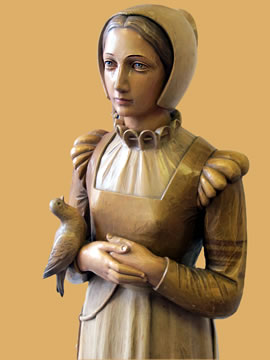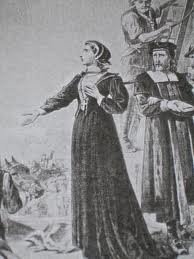
Summary: St Anne Line, the widow of Roger Line, who along with Anne’s brother was arrested in England and banished to Flanders where he died a few years later. Anne was given charge of a house of refuge for priests, was found out, arrested, charged and executed. One of Shakespeare’s enigmatic poems, ‘The Phoenix and the Turtle’, has been interpreted as in praise of the love of St Anne Line and her husband Roger.
Patrick Duffy explains.
A convert from Calvinism
A nne Line was the second daughter of William Heigham of Essex, a strict Calvinist, and was, together with her brother William, disinherited for converting to Catholicism.
nne Line was the second daughter of William Heigham of Essex, a strict Calvinist, and was, together with her brother William, disinherited for converting to Catholicism.
Some time before 1586, she married Roger Line, a young Catholic, who had been disinherited for the same reason. Roger Line and young William Heigham were arrested together while attending Mass, and were imprisoned, fined, and finally banished. Roger Line went to Flanders, where he recived a small allowance from the King of Spain, part of which he sent regularly to his wife until his death around 1594.
In charge of a house of refuge for priests
Around that time Fr John Gerard opened a house of refuge for hiding priests and asked the newly-widowed Anne Line, despite her ill-health, to take charge of it. By 1597 this house had become insecure, so another was opened, and Anne Line was, again, placed in charge. On 2nd February 1601, Fr Francis Page was saying Mass in the house managed by Anne Line, when men arrived to arrest him. The priest managed to slip into a special hiding place, prepared by Anne, and afterwards to escape, but she was arrested, along with two other lay people.
Trial
Tried at the Old Bailey on 26 February, she was so weak that she had to be carried to the trial in a chair. She told the court that far from regretting having concealed a priest, she only grieved that she “could not receive a thousand more”.
Sir John Popham, the judge, sentenced her to hang the next day at Tyburn.
Execution
 Anne Line was hanged on 27 February 1601. She was executed immediately before two priests, Fr Roger Filcock, and Fr Mark Barkworth, though, as a woman, she was spared the disembowelling that they endured. At the scaffold she repeated what she had said at her trial, declaring loudly to the bystanders:
Anne Line was hanged on 27 February 1601. She was executed immediately before two priests, Fr Roger Filcock, and Fr Mark Barkworth, though, as a woman, she was spared the disembowelling that they endured. At the scaffold she repeated what she had said at her trial, declaring loudly to the bystanders:
“I am sentenced to die for harbouring a Catholic priest, and so far am I from repenting for having so done, that I wish, with all my soul, that where I have entertained one, I could have entertained a thousand.”
Fr. Barkworth kissed her hand, while her body was still hanging, saying, “Oh blessed Mrs. Line, who have now happily received thy reward, thou art gone before us, but we shall quickly follow thee to bliss, if it please the Almighty.”
The Phoenix and the Turtle
There is no foolproof documentary evidence that Shakespeare was a Catholic. But in The Times Literary Supplement of April 18, 2003, John Finnis and Patrick Martin argued that Shakespeare’s most enigmatic poem, The Phoenix and Turtle, published in 1601, which up till then had defied all attempts at explanation, is in fact a memorial poem for Anne Line, the Catholic widow executed at Tyburn in 1601 and her husband, Roger.
Let the bird of loudest lay,
On the sole Arabian tree,
Herald sad and trumpet be,
To whose sound chaste wings obey.But thou, shrieking harbinger,
Foul pre-currer of the fiend,
Augur of the fever’s end,
To this troop come thou not near.From this session interdict
Every fowl of tyrant wing,
Save the eagle, feather’d king:
Keep the obsequy so strict.Let the priest in surplice white,
That defunctive music can,
Be the death-divining swan,
Lest the requiem lack his right.And thou, treble-dated crow,
That thy sable gender mak’st
With the breath thou giv’st and tak’st,
‘Mongst our mourners shalt thou go.Here the anthem doth commence:
Love and constancy is dead;
Phoenix and the turtle fled
In a mutual flame from hence.So they lov’d, as love in twain
Had the essence but in one;
Two distincts, division none:
Number there in love was slain.Hearts remote, yet not asunder;
Distance, and no space was seen
‘Twixt the turtle and his queen;
But in them it were a wonder.So between them love did shine,
That the turtle saw his right
Flaming in the phoenix’ sight:
Either was the other’s mine.Property was thus appall’d,
That the self was not the same;
Single nature’s double name
Neither two nor one was call’d.Reason, in itself confounded,
Saw division grow together;
To themselves yet either-neither,
Simple were so well compoundedThat it cried how true a twain
Seemeth this concordant one!
Love hath reason, reason none
If what parts can so remain.Whereupon it made this threne
To the phoenix and the dove,
Co-supreme and stars of love;
As chorus to their tragic scene.Threnos
Beauty, truth, and rarity.
Grace in all simplicity,
Here enclos’d in cinders lie.Death is now the phoenix’ nest;
And the turtle’s loyal breast
To eternity doth rest,Leaving no posterity:–
‘Twas not their infirmity,
It was married chastity.Truth may seem, but cannot be:
Beauty brag, but ’tis not she;
Truth and beauty buried be.To this urn let those repair
That are either true or fair;
For these dead birds sigh a prayer.
+++++++++++++++++++++++++++
******************************
Memorable Proverb for today
True heroism is not the urge to surpass all others at whatever cost,
but the urge to serve others at whatever cost.
~ Arthur Ashe ~
**********************************